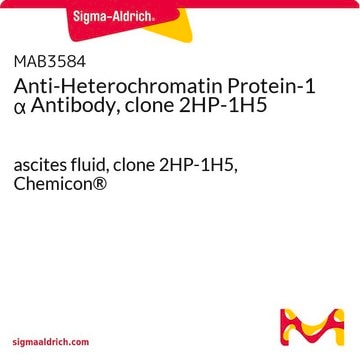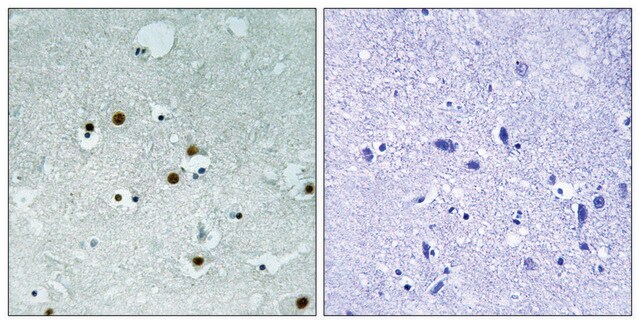05-689
Anti-HP1α Antibody, clone15.19s2
clone 15.19s2, Upstate®, from mouse
Synonym(s):
Antigen p25, HP1 alpha, HP1Hs alpha, Heterochromatin protein 1 homolog alpha, chromobox homolog 5 (Drosophila HP1 alpha), chromobox homolog 5 (HP1 alpha homolog, Drosophila), heterochromatin protein 1-alpha
About This Item
Recommended Products
biological source
mouse
Quality Level
antibody form
purified immunoglobulin
antibody product type
primary antibodies
clone
15.19s2, monoclonal
species reactivity
mouse, vertebrates, human
manufacturer/tradename
Upstate®
technique(s)
ChIP: suitable
immunocytochemistry: suitable
immunohistochemistry: suitable
immunoprecipitation (IP): suitable
western blot: suitable
isotype
IgG1
NCBI accession no.
UniProt accession no.
shipped in
wet ice
target post-translational modification
unmodified
Gene Information
human ... CBX5(23468)
General description
Specificity
Immunogen
Application
A previous lot of this antibody has been reported by an independent laboratory to detect HP1a in NIH/3T3 nuclei (Ayyanathan, K., 2003).
Immunoprecipitation/Chromatin Immunoprecipitation:
A previous lot of this antibody has been reported by an independent laboratory to immunoprecipitate HP1α from nuclear extracts and formalin-cross-linked chromatin (Ayyanathan, K., 2003).
Epigenetics & Nuclear Function
Chromatin Biology
RNA Binding Protein (RBP)
Quality
Western Blot Analysis:
0.5-2 µg/mL of this lot detected HP1α protein in acid-extracted HeLa cell lysates.
Target description
Linkage
Physical form
Storage and Stability
Handling Recommendations:
Upon receipt, and prior to removing the cap, centrifuge the vial and gently mix the solution. Aliquot into microcentrifuge tubes and store at -20°C. Avoid repeated freeze/thaw cycles, which may damage IgG and affect product performance.
Analysis Note
HeLa, NIH/3T3 and COS cell lysates.
Other Notes
Legal Information
Disclaimer
Not finding the right product?
Try our Product Selector Tool.
Storage Class Code
12 - Non Combustible Liquids
WGK
WGK 1
Flash Point(F)
Not applicable
Flash Point(C)
Not applicable
Certificates of Analysis (COA)
Search for Certificates of Analysis (COA) by entering the products Lot/Batch Number. Lot and Batch Numbers can be found on a product’s label following the words ‘Lot’ or ‘Batch’.
Already Own This Product?
Find documentation for the products that you have recently purchased in the Document Library.
Our team of scientists has experience in all areas of research including Life Science, Material Science, Chemical Synthesis, Chromatography, Analytical and many others.
Contact Technical Service








